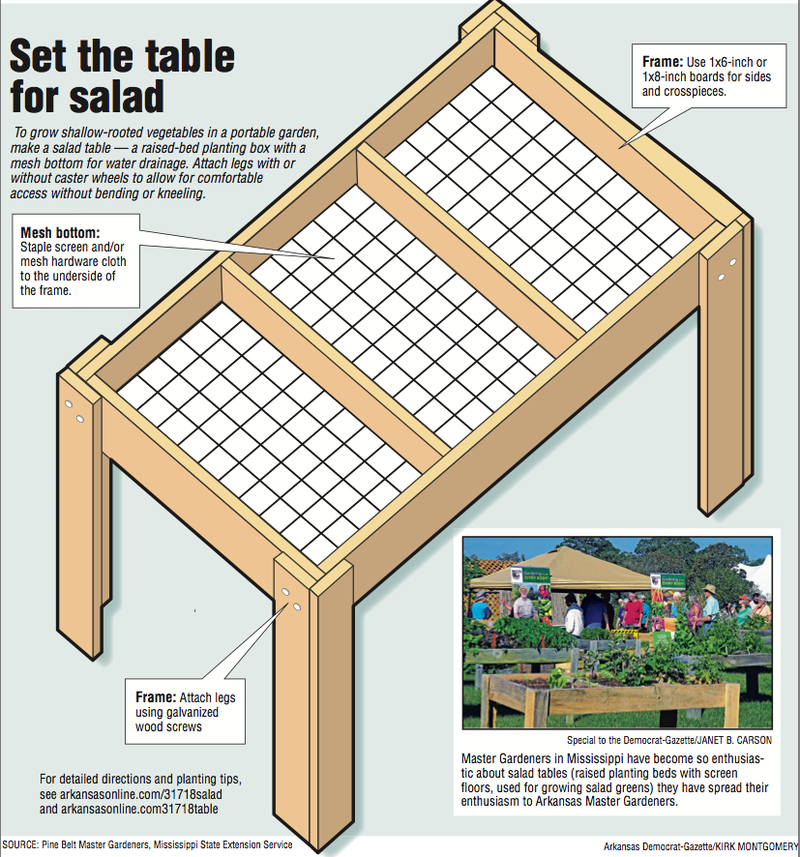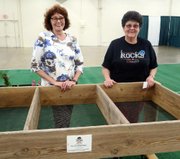The trend of growing your own food has caught on like wildfire. Whether gardeners are doing the traditional in-ground garden or raising a few herbs and tomatoes in containers on their decks, there are more people growing edible gardens than ever before.
For those of us who live in areas with poor, rocky soils, raised beds make the job a lot easier. Raised beds come in all sizes and shapes and are built in many different ways. A version that is beginning to catch on in the South is salad tables.
These are tables that hold salad-vegetable gardens.
The salad table, an elevated and shallow raised-bed garden, can be traced to Maryland in the mid 2000s. Jon Traunfeld, extension horticulture specialist for the University of Maryland, popularized the idea after seeing something similar at an organic farm.
He developed plans to build a table and took the show on the road, speaking at gardening events all over Maryland before branching out to regional and national Master Gardeners events. The concept caught on, and other Master Gardener groups adopted it.
Mississippi State University Extension's Pine Belt Master Gardeners embraced the idea and have been busy building various forms of the salad garden for several years. A group of Master Gardeners from Arkansas saw the Pine Belt gardeners demonstrate their version of the table at the Mississippi State Fall Festival in 2016.
After that workshop, the Lonoke gardeners returned to Mississippi to tour the Pine Belt's tools and shop setup. Inspired, the Lonoke County Master Gardeners now have a full shop of their own and have built at least 30 tables.
For every three or four salad tables they build (depending on construction costs) one table is donated to a nursing home, community garden or a charity.
GROWING GRANDER
The original salad table was basically a 3-inch-deep, 11-square-foot planting box on legs.
The planting box has a hardware-cloth bottom, lined with window screening, so that water can drain but soil mix stays put.
The table is light enough to be lifted by two people; better yet, if you put casters on the legs, it can be rolled. In Maryland, they put the casters on two legs and then tilted the table to move the garden as needed.
In the South, we need a bit more soil depth if a salad garden is going to be functional during the summer. Gardens can be 6 inches or 8 inches deep, but the rest of the basic concept is the same.
A traditional salad garden is waist height, so you can stand to tend it. For those in need of wheelchair height or a child's height, the plans can be adapted.
Salad tables can be placed out in the yard or on a deck or patio -- wherever there is enough light to garden.
If you are growing salad greens or kale, Swiss chard or bok choy, you can move the garden into a bit of shade as the heat of summer progresses.
Since the planting is raised well off the ground, you usually don't have any trouble with Bermuda grass, rabbits, armadillos or groundhogs. Squirrels can gain access and hungry deer might venture near.
The plans to build these gardens are online at the Maryland Extension site (arkansasonline.com/31718salad) and Mississippi State's site (arkansasonline.com/31718table).
Each is a little bit different. Maryland uses untreated lumber while Mississippi State and the Lonoke Master Gardeners use only cypress.
The traditional salad table is 72 inches long by 36 inches wide with 34 inches of ground clearance -- but they can be built to fit your needs.
MAKE YOUR OWN
Soil from the garden should not be used. It would be too heavy, and it would contain weed seeds and possible diseases. Instead, use a combination of lightweight potting soil and compost. Given Arkansas' summer heat, moisture-control potting soil is recommended.
Here are the directions from the Pine Belt Master Gardeners in Mississippi who trained our Lonoke County Master Gardeners.
Decide how long and tall you want your table to be. Typically, tables range from 36 to 72 inches long. Gather these materials:
• 2 pieces of 6-by-1 inch wood for the longer sides of the table, the length you want your table to be
• 2 pieces of 6-by-1 inch wood for the short ends
• 1 or 2 pieces of 6-by-1 inch wood the same length as your short ends -- for crosspieces set 18 inches apart
• 8 pieces of 38-inch-long 4-by-1 inch wood, for legs
• 1 5/8-inch coated exterior wood screws
• 5/8-inch staples
• Galvanized roofing nails
• Fiberglass screen
• Hardware cloth
• Drill or electric screwdriver
• Staple gun
• Circular saw or table saw (if wood is not pre-cut)
1. Create the frame of the salad table top using the 6-inch-by-1-inch wood. Screw two of the shorter pieces to the two longer pieces to create a rectangle. Use 1 5/8 inch or larger coated exterior wood screws. Be sure the corners are square.
2. Slide the other short piece(s) of wood into the middle of rectangle to create crosspiece(s). Use wood screws to attach each crosspiece to the frame. Place one crosspiece about every 18 inches.
3. Turn the frame so that the side you want to become the bottom is facing up. Staple fiberglass screen to the box with 5/8-inch staples.
4. Nail the hardware cloth over the fiberglass screen using galvanized roofing nails.
5. Now add the legs. Each leg is formed by two pieces of 38-inch-long 4-by-1. The legs meet at right angles on the outside edge of each corner. Screw the legs to the table top using 1 5/8-inch coated exterior wood screws.
6. Use a lightweight potting soil mix to plant your table. You can use transplants or seeds to fill your table with shallow-rooted plants. You may need to water more frequently in hot, dry weather.
LET SOMEONE ELSE DO IT
The Lonoke County Master Gardeners will build a salad table for you. They charge $85 for a 6-foot table that's 3 feet wide and 6 inches deep; $100 for a similar table with an 8-inch-deep planting box. Swivel rollers can be added for an extra $40.
But at the recent Arkansas Flower & Garden Show on the Arkansas State Fairgrounds, where the Lonoke group had a demonstration table, they were inundated with orders. A small group of volunteers is fulfilling the orders, so it might not be a quick turn-around. (They also have 12-inch by 18-inch herb boxes for sale.)
Call the Lonoke County office for more information at (501) 676-3124.
Once you have a salad table, the sky is the limit on what you can grow.
Tall and deep-rooted vegetables will be more of a challenge, but when growing any flowers, vegetables and herbs, remember to fertilize regularly and water as needed. Drip irrigation systems could also be an easy irrigation method to install; they help you keep up with the watering needs while keeping the foliage dry.
Janet B. Carson is a horticulture specialist for the University of Arkansas Cooperative Extension Service.
HomeStyle on 03/17/2018


